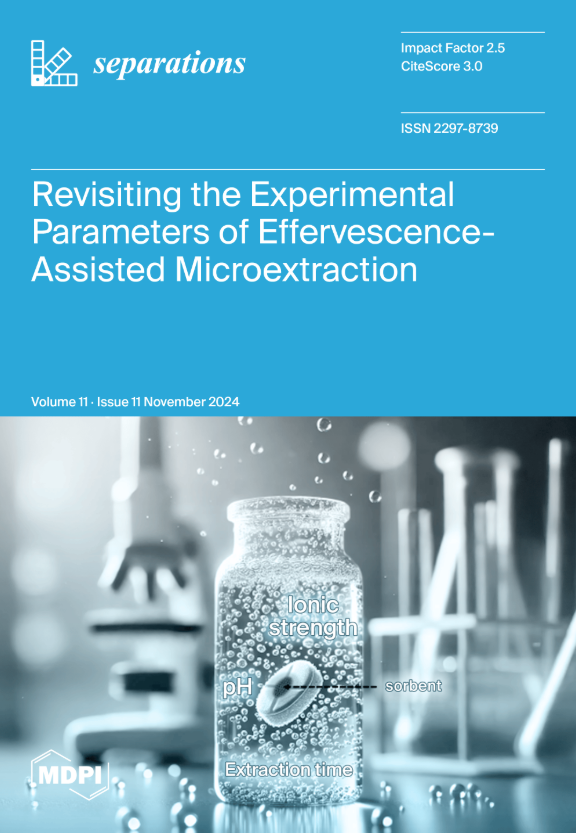稀土掺杂对纳米TiO2纳米管/SnO2-Sb电极电化学处理工业废水结构和电催化性能的影响
IF 2.7
4区 工程技术
Q3 CHEMISTRY, ANALYTICAL
引用次数: 0
摘要
采用溶剂热合成技术在tnt阵列衬底上成功制备了一系列稀土掺杂SnO2-Sb电极,作为电催化降解苯酚的负极材料。与未掺杂的电极相比,掺杂稀土元素的电极表现出更好的电催化活性和稳定性。详细研究了在前驱体溶液中添加稀土元素(即Gd和Nd)对tnt /SnO2-Sb电极结构和性能的影响。SEM和XRD结果表明,与tnt /SnO2-Sb-Nd相比,由于Gd元素的离子半径较小,tnt /SnO2-Sb-Gd具有更细的晶粒尺寸。这有助于其融入SnO2晶格内部并抑制晶粒生长,导致颗粒尺寸显着减小,从而暴露更多的活性位点。通过XPS、EPR、LSV、EIS和羟基自由基(•OH)生成测试,探讨稀土掺杂对电化学活性的影响机理。结果表明,电催化活性的增强可归因于电极表面氧空位的生成增加,这些空位作为活性位点增强了氧的吸附,促进了•OH的生成。本文章由计算机程序翻译,如有差异,请以英文原文为准。
Effects of Rare Earth Doping on Structural and Electrocatalytic Properties of Nanostructured TiO2 Nanotubes/SnO2-Sb Electrode for Electrochemical Treatment of Industrial Wastewater
The solvothermal synthesis technique was employed to successfully fabricate a series of rare earth doped SnO2-Sb electrodes on the TNTs array substrate, serving as anode material for electrocatalytic degradation of phenol. The electrode doped with rare earth elements demonstrated superior electrocatalytic activity and stability in comparison to the undoped electrode. The influence of adding rare earth elements (i.e., Gd and Nd) into the precursor solution on the structural and property of TNTs/SnO2-Sb electrodes was studied in detail. The results obtained from SEM and XRD indicated that, compared to TNTs/SnO2-Sb-Nd, TNTs/SnO2-Sb-Gd exhibited a finer grain size due to the smaller ionic radius of the Gd element. This facilitated its incorporation into the SnO2 lattice interior and inhibited grain growth, resulting in a significant decrease in particle size for exposing more active sites. The influence mechanism of rare earth doping on electrochemical activity was investigated through XPS, EPR, LSV, EIS and Hydroxyl radicals (•OH) generation tests. The results demonstrated that the enhanced electrocatalytic activity can be attributed to an increased generation of oxygen vacancies on the electrode surface, which act as active sites for enhancing the adsorption of oxygen species and promoting •OH generation.
求助全文
通过发布文献求助,成功后即可免费获取论文全文。
去求助
来源期刊

Separations
Chemistry-Analytical Chemistry
CiteScore
3.00
自引率
15.40%
发文量
342
审稿时长
12 weeks
期刊介绍:
Separations (formerly Chromatography, ISSN 2227-9075, CODEN: CHROBV) provides an advanced forum for separation and purification science and technology in all areas of chemical, biological and physical science. It publishes reviews, regular research papers and communications. Our aim is to encourage scientists to publish their experimental and theoretical results in as much detail as possible. There is no restriction on the length of the papers. The full experimental details must be provided so that the results can be reproduced. There are, in addition, unique features of this journal:
Manuscripts regarding research proposals and research ideas will be particularly welcomed.
Electronic files and software regarding the full details of the calculation and experimental procedure, if unable to be published in a normal way, can be deposited as supplementary material.
Manuscripts concerning summaries and surveys on research cooperation and projects (that are funded by national governments) to give information for a broad field of users.
The scope of the journal includes but is not limited to:
Theory and methodology (theory of separation methods, sample preparation, instrumental and column developments, new separation methodologies, etc.)
Equipment and techniques, novel hyphenated analytical solutions (significantly extended by their combination with spectroscopic methods and in particular, mass spectrometry)
Novel analysis approaches and applications to solve analytical challenges which utilize chromatographic separations as a key step in the overall solution
Computational modelling of separations for the purpose of fundamental understanding and/or chromatographic optimization
 求助内容:
求助内容: 应助结果提醒方式:
应助结果提醒方式:


